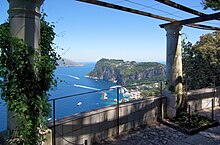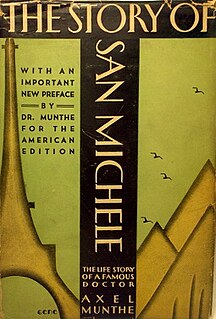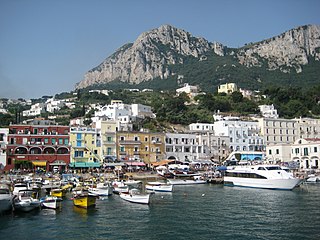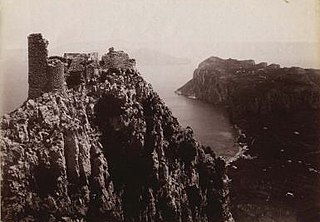

The Villa San Michele was built about the end of the 19th century on the isle of Capri, Italy, by the Swedish physician and author Axel Munthe. [1]


The Villa San Michele was built about the end of the 19th century on the isle of Capri, Italy, by the Swedish physician and author Axel Munthe. [1]
The villa's gardens have panoramic views of the town of Capri and its harbour, the Sorrentine Peninsula, and Mount Vesuvius. The villa sits on a ledge at the top of the Phoenician Steps, between Anacapri and Capri, at a height of 327 metres (1,073 ft) above sea level.
San Michele's gardens are adorned with many relics and works of art dating from ancient Egypt and other periods of classical antiquity. They now form part of the Grandi Giardini Italiani.
In his later years, Axel Munthe wrote his youthful memoir The Story of San Michele , which describes how he first visited the island and built the villa, decorated with the remains of palaces built by the Ancient Romans which he found on his land. This colourfully written book was first published in 1929 and became an immediate worldwide success, being translated into many languages. It has been reprinted many times since then.
Between 1919 and 1920, Munthe was an unwilling landlord to the outrageous socialite and muse Luisa Casati, who took possession of Villa San Michele. This was described by the Scottish author Compton Mackenzie in his diaries. [2]

Axel Martin Fredrik Munthe was a Swedish-born medical doctor and psychiatrist, best known as the author of The Story of San Michele, an autobiographical account of his life and work. He spoke several languages, grew up in Sweden, attended medical school there, then studied medicine in Paris and opened his first practice in France. He was married to a wealthy Englishwoman and spent most of his adult life in Italy. His philanthropic nature often led him to treat the poor without charge, and he risked his life on several occasions to offer medical help in times of war, disaster, or plague. As an advocate of animal rights, he purchased land to create a bird sanctuary near his home in Italy, argued for bans on painful traps, and himself kept pets as diverse as an owl and a baboon, as well as many types of dog. His writing is light-hearted, being primarily memoirs drawn from his real-life experiences, but it is often tinged with sadness or tragedy, and often uses dramatic licence. He primarily wrote about people and their idiosyncrasies, portraying the foibles of both the rich and the poor, but also about animals.

Sophie Marie Victoria of Baden was Queen of Sweden from 8 December 1907 until her death in 1930 as the wife of King Gustaf V. She was politically active in a conservative fashion during the development of democracy and known to be pro-German during the First World War.

Capri is an island located in the Tyrrhenian Sea off the Sorrento Peninsula, on the south side of the Gulf of Naples in the Campania region of Italy. The main town of Capri that is located on the island shares the name. It has been a resort since the time of the Roman Republic.

The Villa d'Este is a 16th-century villa in Tivoli, near Rome, famous for its terraced hillside Italian Renaissance garden and especially for its profusion of fountains. It is now an Italian state museum, and is listed as a UNESCO World Heritage Site.

Amedeo Maiuri was an Italian archaeologist, famous for his archaeological investigations of the Roman city of Pompeii which was destroyed in the eruption of Mount Vesuvius in August of AD 79. He was the first to conduct systematic scientific excavations, analysis and publication at Pompeii and other sites around Vesuvius.

Luisa, Marchesa Casati Stampa di Soncino, was an Italian heiress, muse, and patroness of the arts in early 20th-century Europe.
The Hasselblad Foundation, established in 1979 at the will of Victor Hasselblad, is a fully independent, not-for-profit foundation based at Götaplatsen in Gothenburg, Sweden. The main aim of the Foundation is to promote research and academic teaching in the natural sciences and photography. The Foundation also presents an annual international award in photography to “a photographer recognized for major achievements”.
The island of Capri is situated in the Gulf of Naples, between the Italian Peninsula and the islands of Procida and Ischia. Made of limestone, its lowest part is at the center, while its sides are high and mostly surrounded by steep precipices, which contain numerous caves. Its topography is dominated by the slopes of the Monte Solaro in the West and Monte San Michele the East.

Memories and Vagaries is a collection of short memoirs and essays by Axel Munthe published in several languages and editions, with differing contents and ordering.

The Story of San Michele is a book of memoirs by Swedish physician Axel Munthe first published in 1929 by British publisher John Murray. Written in English, it was a bestseller in numerous languages and has been republished constantly in the nine decades since its original release.
Major Malcolm Grane Ludovic Martin Munthe MC was a British soldier, writer, and curator, and son of the Swedish doctor and writer Axel Munthe and his English second wife Hilda Pennington-Mellor.

Villa Le Balze is a garden villa in Fiesole, a comune of the Metropolitan City of Florence and the region of Tuscany in central Italy. The villa was commissioned and built by Charles Augusts Strong in 1913, where he spent much of his life. It was then embroiled in the fighting of the Second World War and came into the possession of Margaret Rockefeller Strong. The villa is today owned by Georgetown University and hosts year-round study abroad students focused on interdisciplinary study of Italian culture and civilization, as well as such other subjects as politics and history.

Villa Cimbrone is a historic villa in Ravello, on the Amalfi Coast of southern Italy. Dating from at least the 11th century, it is famous for its scenic belvedere, the Terrazza dell'Infinito.

The Italian Renaissance garden was a new style of garden which emerged in the late 15th century at villas in Rome and Florence, inspired by classical ideals of order and beauty, and intended for the pleasure of the view of the garden and the landscape beyond, for contemplation, and for the enjoyment of the sights, sounds and smells of the garden itself.

The Phoenician Steps of Capri are a long and steep stone stairway that unites the population center of Capri with that of Anacapri. The stairway was made probably by ancient Greek colonists, however, rather than by Phoenicians.

The Italian garden (or giardino all'italiana is best known for a number of large Italian Renaissance gardens which have survived in something like their original form. In the history of gardening, during the Renaissance, Italy had the most advanced and admired gardens in Europe, which greatly influenced other countries, especially the French formal garden and Dutch gardens and, mostly through these, gardens in Britain.

Monte Solaro is a mountain on the island of Capri in Campania, Italy. With an elevation of 589 m, its peak is the highest point of Capri.
Palazzo a Mare is a well-preserved ancient Roman archaeological site on the north side of the island of Capri, consisting of an imperial palace built by Augustus and modified by Tiberius. It was one of the supposed twelve villas of Tiberius on the island as described by Tacitus, along with the Villa Jovis, Villa di Gradola and Villa Damecuta. It covers a very large area on several terraces overlooking the sea.
Torre Materita is an ancient medieval tower converted into a villa located in the comune of Anacapri, Capri.

Castello Barbarossa is an archaeological ruin and ornithological station in Anacapri, on the island of Capri, Italy. It is named after the former corsair and Ottoman Kapudan Pasha (Admiral) Hayreddin Barbarossa, who stormed it in 1535 and destroyed it in 1544. The construction date is uncertain but it perhaps dates back to the late ninth century. From 1898, the structure, now in ruins, was owned by the Swedish psychiatrist Axel Munthe who donated it to his foundation. The surroundings, interesting for their botanical features, are home to the island's ornithological station.